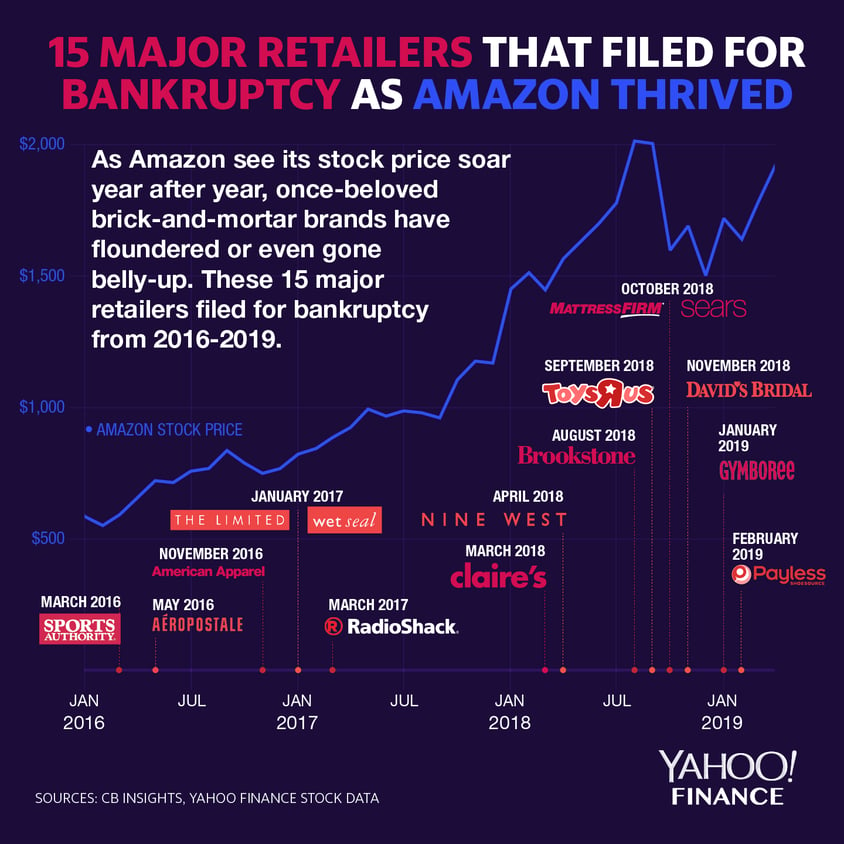In our latest Engagement Marketing Master Class: How to Acquire First-Party Data by Engaging...
3 Mistakes from Failing Retailers that Marketers Can Learn From
 What do consumers really want from brick-and-mortar retailers today? As rumours swirl that the retail giant Forever 21 is preparing to file for bankruptcy, it begs a few questions: What did they do wrong? But more importantly, what can they do better? The news cites poor decision making on the retail level, which includes a number of missteps since the peak of Forever 21’s success. However, they are far from the only budding retailer to suffer such a blow. Aeropostale, American Apparel, Wet Seal, Claire’s, Toys ‘R Us, among others are amongst those forced to declare bankruptcy in recent years.
What do consumers really want from brick-and-mortar retailers today? As rumours swirl that the retail giant Forever 21 is preparing to file for bankruptcy, it begs a few questions: What did they do wrong? But more importantly, what can they do better? The news cites poor decision making on the retail level, which includes a number of missteps since the peak of Forever 21’s success. However, they are far from the only budding retailer to suffer such a blow. Aeropostale, American Apparel, Wet Seal, Claire’s, Toys ‘R Us, among others are amongst those forced to declare bankruptcy in recent years.
So, much like a business school case study, let’s look at how this young-adult retailer lost relevancy in the eyes of today’s consumers, how they can move forward, and how other retailers can learn from their mistakes.
Bigger Isn’t Better
Gone are the days of large overstocked brick-and-mortar stores. According to a report by Yahoo News, “…consumers are changing their buying habits — from shopping purely in brick and mortar to buying more online — there’s less need to carry the merchandise.” And so it becomes “a matter of how much space do you allocate for those walk in customers, or those customers who still prefer to shop in brick-and-mortar versus those shoppers who prefer to buy online,” said Roger Beahm, executive director of the Center for Retail Innovation at Wake Forest University.
And at the end of the day, it comes down to how quickly the company can evolve to match shifting consumer trends.
There’s an ongoing debate about whether retail, or more specifically, brick and mortar retail is dead. However, Beahm believes that retail is an integral part of our social behaviour. He says there is only one thing we know for sure, and thats “…retail’s one of the things that have been around since antiquity. So retail is not going to go away…The only thing that’s going to change… is the old way of doing things being replaced by the new way of doing things.”
The Lesson
New retailers must take stock of how much product and space they invest in. Exclusively in the retail industry is much more attractive to consumers today. Less is more, and seeing is not necessarily believing anymore. Instead, retailers should take a chapter out of Amazon’s playbook; keep stock in rented warehouses rather than hundreds of massive brick-and-mortar locations. Consumers are willing to make online purchases for products they really want. Plus, this helps cut costs on retail, and local distribution is faster and less expensive than any international competitors.
Being Tone Deaf On Social Issues
Forever 21’s target audience includes mostly Millennials and Gen-Zs. And you don’t have to be a marketing expert to know how much this generation cares about social issues. So, needless to say when Forever 21 sent free diet bars to customers who purchased plus-size clothing online, it was not received well. Clearly, this was not a well thought out marketing strategy. Nor was it a smart move considering the company’s target market, no matter what sizes they were purchasing.
This was not the first time the company ignored social issues in favour of profit. In 2013, Forever 21 was accused of cultural appropriation after releasing NWA-inspired “Straight Outta Compton” t-shirts and the retailer violated the Indian Arts and Crafts Act of 1990 when they used the word “Navajo” to describe various items including a pair of panties.
Another issues close to many Millennials hearts is supporting independent artists and designers. As the most overeducated and underpaid generation of its kind, there’s nothing like a corporate conglomerate benefiting off of independent creatives. However, that hasn’t stopped them from doing it over and over again. For example, a freelance artist named Sam Larson noticed typography he made of the world “Wild” that he posted on his Instagram was copied by Forever 21 and put on a shirt two years later. In a separate indecent, another artist who posted an image she created on Tumblr was upset to find Forever 21 was using it on one of their men’s graphic tees without permission.
Indie designers were not the only ones who fell victim to Forever 21 ripoffs. Anna Sui, Diane Von Furstenberg and Anthropologie are a few of the established brands that filed copyright suits against the company, claiming they replicated designs.
The Lesson
It’s important to be purpose-driven in your marketing. Understand what your consumers care about, and ensure your brand shares the same vision. Millennials want to be able to relate to the brands they shop with, and if they feel your ideology is not in line with their own, they will flee. Today’s retailers cannot hide from aligning themselves with social causes and distancing themselves with others. But by staying on the pulse of current social issues your brand can thrive in the marketplace.
Not Having an Up to Date Digital Strategy
Today, having a website, or an eCommerce site is just not enough. Retailers must make an effort to connect with consumers on many digital touch-points. At one time, Forever 21’s website was one of the best parts of its marketing strategy. Given its over-merchandised retail locations, the website gave consumers the opportunity to browse their style in a more organized fashion. Plus, their shipping and delivery was relatively speedy since each location was basically its own warehouse. But as oversees competitors, selling similar products, began to crop up online, Forever 21 didn’t recognize the threat. Their digital strategy needed innovation. It lacked an engagement and loyalty component, and the fickle attitude of their target customers naturally led to their recent shortcomings.
By integrating engaging digital campaigns for younger consumers to connect with, their legacy may have a more fruitful future. Of course, the retailer has yet to announce its bankruptcy (we’ll be sure to update this, if they do) but one thing is for sure, losing touch with online consumer trends has contributed to their recent struggles.
The Lesson
Digital marketing is always evolving and retailers must evolve their tactics to meet consumer expectations. Plus, digital transformation cannot happen overnight. If you fall too far behind you may risk not being able to catch up to your competition. In order to keep up with current trends marketers must always consider whats on the horizon. As mobile and digital communication takes over, retailers must incorporate this into multiple touch-points. Also, executing thoughtful campaigns in a digital environment, you can better connect to and engage today’s consumers.
White Paper: 2019 Consumer Engagement Trends Report
In 2019 companies will begin connecting data and content to deliver on the notion of personalization. This report assists brand marketers and agencies looking to engage consumers in the digital-first era. It outlines 10 emerging trends and technologies that marketers need for personalizing communications along the customer journey.
WHAT’S INSIDE:
- The Value of Data-Driven Creatives
- 5G and Mobile-First Marketing
- Leveraging The Internet of Things (IoT)
- Experience-Driven Marketing
- Plus, So Much More!
Download the FREE 14-page report today!






